From the Trenches
Partially Identified Flying Objects
By DANIEL WEISS
Monday, August 12, 2019
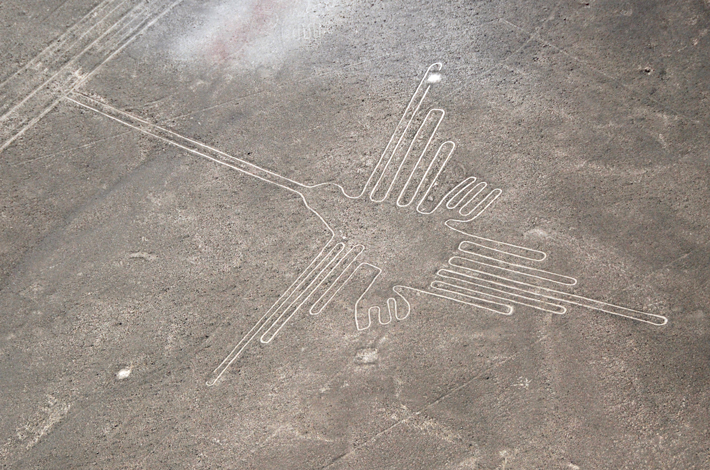 Sixteen of the mysterious geoglyphs known as the Nazca Lines depict birds—more than any other type of plant or animal. A team of researchers from Japan recently set out to determine which bird species were rendered in the deserts of southern Peru between 2,400 and 1,300 years ago. They have concluded that one image, previously identified simply as a hummingbird, actually represents a specific type of hummingbird called a hermit, which is distinguished by its long, pointed tail.
Sixteen of the mysterious geoglyphs known as the Nazca Lines depict birds—more than any other type of plant or animal. A team of researchers from Japan recently set out to determine which bird species were rendered in the deserts of southern Peru between 2,400 and 1,300 years ago. They have concluded that one image, previously identified simply as a hummingbird, actually represents a specific type of hummingbird called a hermit, which is distinguished by its long, pointed tail.
 Two geoglyphs were found to show pelicans, and another appears to be a baby parrot. The geoglyph creators must have had a penchant for depicting exotic species, as none of these birds live in the Nazca region. In a number of cases, the avians had features that could not be reconciled with any known bird. “I don’t think all the Nazca bird geoglyphs were modeled on real bird species,” says Masaki Eda of the Hokkaido University Museum. “I think some of them combined the traits of several different birds.”
Two geoglyphs were found to show pelicans, and another appears to be a baby parrot. The geoglyph creators must have had a penchant for depicting exotic species, as none of these birds live in the Nazca region. In a number of cases, the avians had features that could not be reconciled with any known bird. “I don’t think all the Nazca bird geoglyphs were modeled on real bird species,” says Masaki Eda of the Hokkaido University Museum. “I think some of them combined the traits of several different birds.”
Volcano Viewers
By BENJAMIN LEONARD
Monday, August 12, 2019
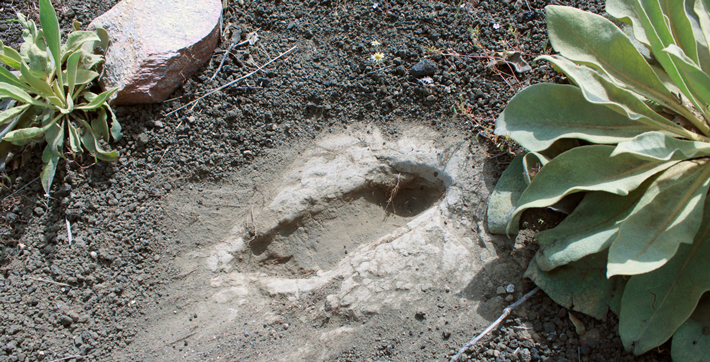
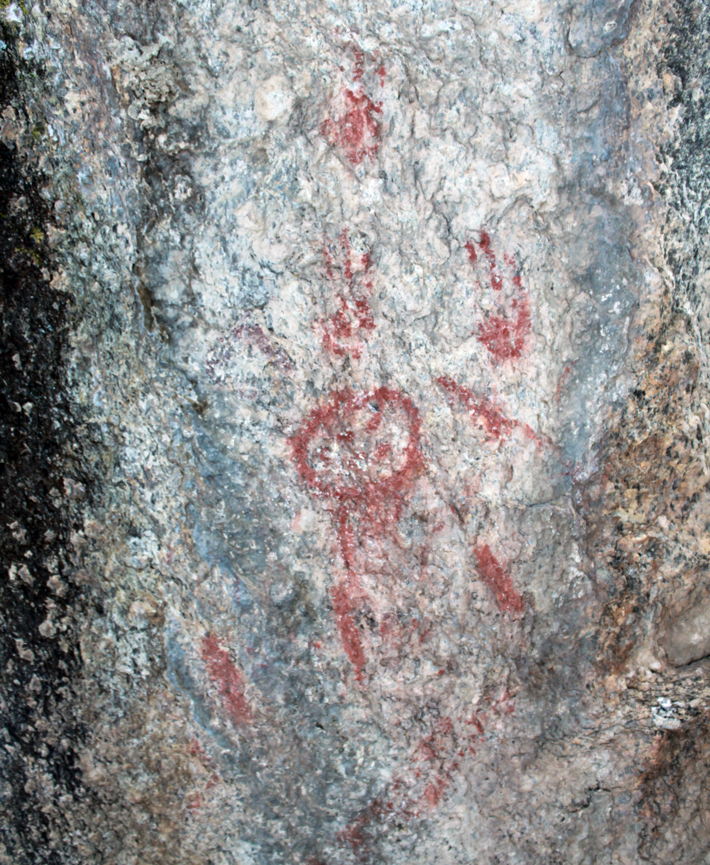 More than 50 years ago, human footprints were found preserved in volcanic ash near the Çakallar volcano in western Turkey. Since then, experts have tried to figure out when the eruption that cemented the prints in the earth occurred. Now, a team led by geologist İnan Ulusoy of Hacettepe University has produced a definitive answer. Using dating methods that measure the time since the basaltic lava flow first reached Earth’s surface and the time since external rocks carried by the volcano’s molten magma were last heated, they calculated that the eruption occurred approximately 4,700 years ago.
More than 50 years ago, human footprints were found preserved in volcanic ash near the Çakallar volcano in western Turkey. Since then, experts have tried to figure out when the eruption that cemented the prints in the earth occurred. Now, a team led by geologist İnan Ulusoy of Hacettepe University has produced a definitive answer. Using dating methods that measure the time since the basaltic lava flow first reached Earth’s surface and the time since external rocks carried by the volcano’s molten magma were last heated, they calculated that the eruption occurred approximately 4,700 years ago.
Ulusoy and his team also propose that a recently documented pictograph painted on a boulder at a rock shelter just over a mile from the footprints may be an illustration of Çakallar’s eruption made by Bronze Age people who saw it firsthand. The painting appears to depict a volcanic crater, with red dots that could represent glowing vents and a thick red line that may indicate the lava flow that breached the crater’s edge. Says Ulusoy, “I think what prehistoric people witnessed were relatively mild, low-intensity eruptions that you could watch from a safe distance.”
Saqqara's Working Stiffs
By ZACH ZORICH
Monday, August 12, 2019
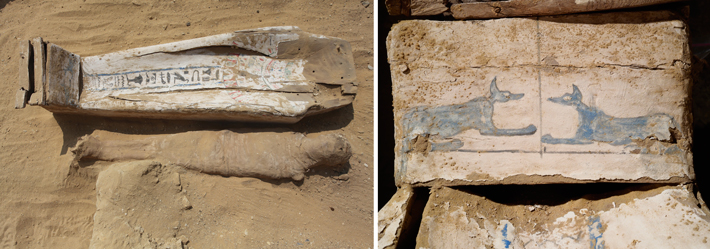 Thirty-six mummies dating to between 600 B.C. and A.D. 100 have been discovered by a team of Polish archaeologists in Saqqara, the ancient cemetery of the city of Memphis in Egypt. These mummies received only the simplest embalming, explains excavation director Kamil Kuraszkiewicz, an Egyptologist at the University of Warsaw. “There are no inscriptions or personal items that would hint at these people’s names or professions,” he says, “but analysis of skeletal remains indicates that they mostly performed hard labor.” Of the very few coffins found with the mummies, one was decorated with a nonsensical hieroglyphic inscription and rough depictions of jackals meant to represent Anubis, the god of death. The designs seem to imitate coffins found in high-status burials.
Thirty-six mummies dating to between 600 B.C. and A.D. 100 have been discovered by a team of Polish archaeologists in Saqqara, the ancient cemetery of the city of Memphis in Egypt. These mummies received only the simplest embalming, explains excavation director Kamil Kuraszkiewicz, an Egyptologist at the University of Warsaw. “There are no inscriptions or personal items that would hint at these people’s names or professions,” he says, “but analysis of skeletal remains indicates that they mostly performed hard labor.” Of the very few coffins found with the mummies, one was decorated with a nonsensical hieroglyphic inscription and rough depictions of jackals meant to represent Anubis, the god of death. The designs seem to imitate coffins found in high-status burials.
Inner Beauty
By MARCO MEROLA
Monday, August 12, 2019
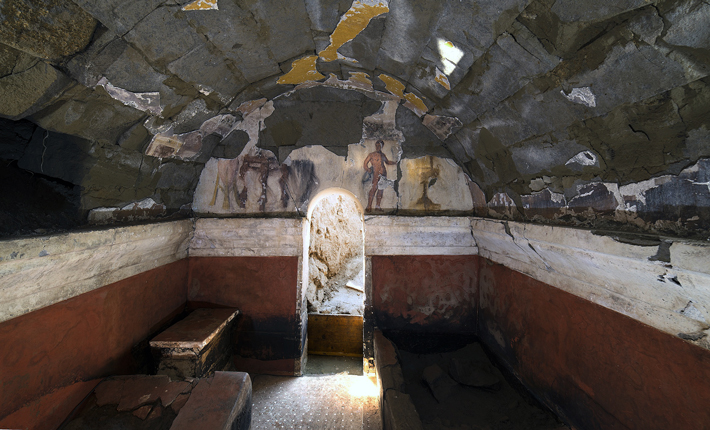 In a necropolis at the site of Cumae, near Naples in southern Italy, archaeologists have uncovered a painted tomb dating to the second century B.C. Cumae is the oldest Greek settlement in Italy, founded sometime in the eighth century B.C. It is also the home of the Cumaean sibyl, a prophetess who, like her counterpart at Delphi in Greece, presided over a sanctuary of Apollo. Like the sibyl, Cumae maintained its importance for centuries. It was the home of a large community of non-Latin-speaking local Italic people called Oscans who settled there in the fifth century B.C., and remained influential into the second and first centuries B.C., explains archaeologist Priscilla Munzi of the French National Center for Scientific Research.
In a necropolis at the site of Cumae, near Naples in southern Italy, archaeologists have uncovered a painted tomb dating to the second century B.C. Cumae is the oldest Greek settlement in Italy, founded sometime in the eighth century B.C. It is also the home of the Cumaean sibyl, a prophetess who, like her counterpart at Delphi in Greece, presided over a sanctuary of Apollo. Like the sibyl, Cumae maintained its importance for centuries. It was the home of a large community of non-Latin-speaking local Italic people called Oscans who settled there in the fifth century B.C., and remained influential into the second and first centuries B.C., explains archaeologist Priscilla Munzi of the French National Center for Scientific Research.
The Oscan tomb is constructed of huge blocks of tufa. Unlike the other tombs found in the necropolis, however, whose inner walls are simply plastered, or, at most, plastered and painted white or red, this tomb’s walls are covered with a banquet scene above the entryway and landscapes on the ceiling and sidewalls. Along three walls, there are stone beds for the deceased. The necropolis was eventually abandoned and covered over by an artificial terrace built by the Romans in the first century A.D. and used for military training.
Home on the Plains
By DANIEL WEISS
Monday, August 12, 2019
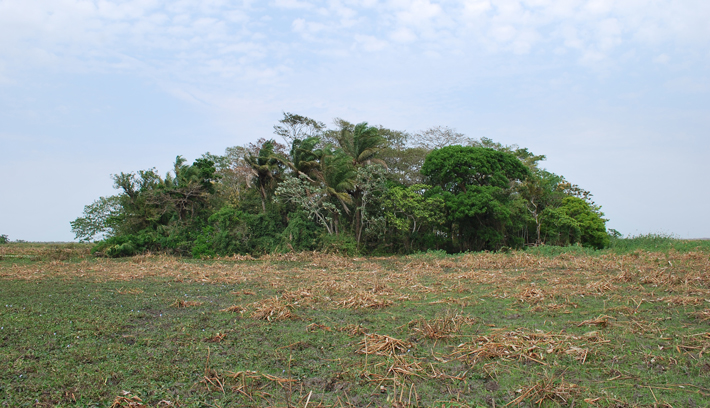
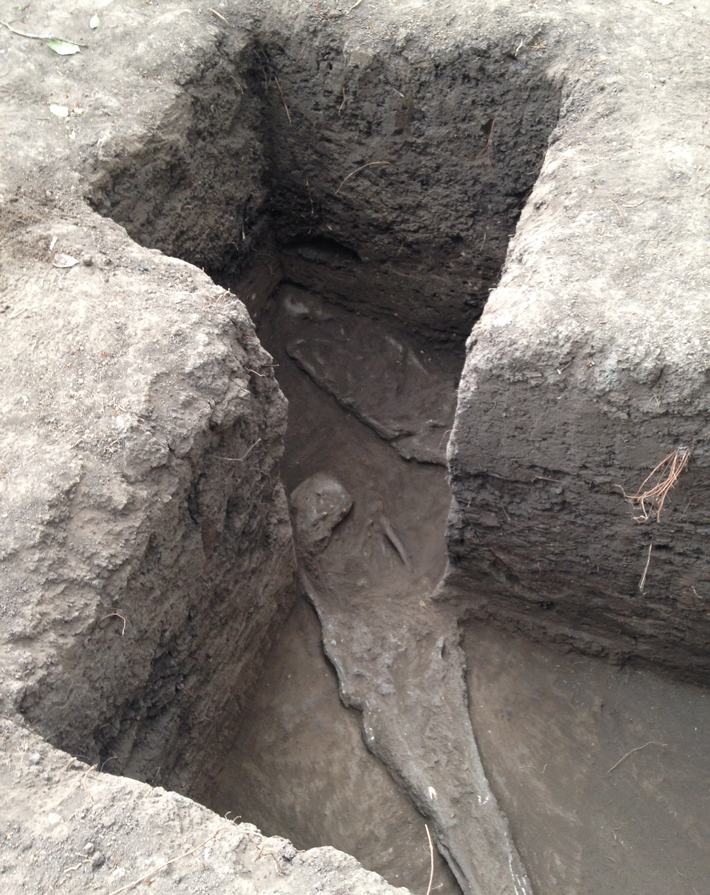 The earliest known settlements in southwestern Amazonia date to thousands of years before the rise of agriculture in the area. Researchers have found that between 10,600 and 4,000 years ago, hunter-gatherers settled for at least part of the year at sites in an expanse of tropical savanna known as the Llanos de Moxos in northern Bolivia. Led by José Capriles, an archaeologist at Penn State University, the team carried out excavations at three forest islands—wooded areas slightly elevated above the surrounding plains. There they found layers of charcoal, snail shells, and bones of animals ranging from fish and deer to snakes and armadillos.
The earliest known settlements in southwestern Amazonia date to thousands of years before the rise of agriculture in the area. Researchers have found that between 10,600 and 4,000 years ago, hunter-gatherers settled for at least part of the year at sites in an expanse of tropical savanna known as the Llanos de Moxos in northern Bolivia. Led by José Capriles, an archaeologist at Penn State University, the team carried out excavations at three forest islands—wooded areas slightly elevated above the surrounding plains. There they found layers of charcoal, snail shells, and bones of animals ranging from fish and deer to snakes and armadillos.
Capriles believes that people spent a portion of each year at the forest islands, most likely during the rainy season when lower-lying areas flooded, and that they came to see the sites as home. In addition to evidence of what people ate, the team unearthed five complete human skeletons encrusted in calcium carbonate that had leached from the soil. The bones were too degraded to be dated, but appear to have been intentionally buried between 7,000 and 6,000 years ago, based on radiocarbon dating of charcoal associated with them. “If your ancestors are buried in a place, you feel a stronger connection to it and can make an argument that it’s yours,” says Capriles. “The burials may also have created a sort of social memory that tied people together in these places.”
Advertisement
Advertisement
IN THIS ISSUE
From the Trenches
The Case for Clotilda
Off the Grid
A God Goes Shopping
Half in the Bag
Herding Genes in Africa
Bronze Age Palace Surfaces
Upper Paleolithic Cave Life
Scarab From Space
A Catalog of Princes
Sowing the Land
We Are Family
Home on the Plains
Saqqara's Working Stiffs
Inner Beauty
Volcano Viewers
Partially Identified Flying Objects
World Roundup
Egyptian watermelons, a Sumatran tsunami, Siege of Yorktown shipwrecks, and the house of the nine-day queen
Artifact
Just a fleeting impression
Advertisement

Recent Issues
-
 May/June 2024
May/June 2024
-
 March/April 2024
March/April 2024
-
 January/February 2024
January/February 2024
-
 November/December 2023
November/December 2023
-
 September/October 2023
September/October 2023
-
 July/August 2023
July/August 2023
-
 May/June 2023
May/June 2023
-
 March/April 2023
March/April 2023
-
 January/February 2023
January/February 2023
-
 November/December 2022
November/December 2022
-
 September/October 2022
September/October 2022
-
 July/August 2022
July/August 2022
-
 May/June 2022
May/June 2022
-
 March/April 2022
March/April 2022
-
 January/February 2022
January/February 2022
-
 November/December 2021
November/December 2021
-
 September/October 2021
September/October 2021
-
 July/August 2021
July/August 2021
-
 May/June 2021
May/June 2021
-
 March/April 2021
March/April 2021
-
 January/February 2021
January/February 2021
-
 November/December 2020
November/December 2020
-
 September/October 2020
September/October 2020
-
 July/August 2020
July/August 2020
-
 May/June 2020
May/June 2020
-
 March/April 2020
March/April 2020
-
 January/February 2020
January/February 2020
-
 November/December 2019
November/December 2019
-
 September/October 2019
September/October 2019
-
 July/August 2019
July/August 2019
-
 May/June 2019
May/June 2019
-
 March/April 2019
March/April 2019
-
 January/February 2019
January/February 2019
-
 November/December 2018
November/December 2018
-
 September/October 2018
September/October 2018
-
 July/August 2018
July/August 2018
-
 May/June 2018
May/June 2018
-
 March/April 2018
March/April 2018
-
 January/February 2018
January/February 2018
-
 November/December 2017
November/December 2017
-
 September/October 2017
September/October 2017
-
 July/August 2017
July/August 2017
-
 May/June 2017
May/June 2017
-
 March/April 2017
March/April 2017
-
 January/February 2017
January/February 2017
-
 November/December 2016
November/December 2016
-
 September/October 2016
September/October 2016
-
 July/August 2016
July/August 2016
-
 May/June 2016
May/June 2016
-
 March/April 2016
March/April 2016
-
 January/February 2016
January/February 2016
-
 November/December 2015
November/December 2015
-
 September/October 2015
September/October 2015
-
 July/August 2015
July/August 2015
-
 May/June 2015
May/June 2015
-
 March/April 2015
March/April 2015
-
 January/February 2015
January/February 2015
-
 November/December 2014
November/December 2014
-
 September/October 2014
September/October 2014
-
 July/August 2014
July/August 2014
-
 May/June 2014
May/June 2014
-
 March/April 2014
March/April 2014
-
 January/February 2014
January/February 2014
-
 November/December 2013
November/December 2013
-
 September/October 2013
September/October 2013
-
 July/August 2013
July/August 2013
-
 May/June 2013
May/June 2013
-
 March/April 2013
March/April 2013
-
 January/February 2013
January/February 2013
-
 November/December 2012
November/December 2012
-
 September/October 2012
September/October 2012
-
 July/August 2012
July/August 2012
-
 May/June 2012
May/June 2012
-
 March/April 2012
March/April 2012
-
 January/February 2012
January/February 2012
-
 November/December 2011
November/December 2011
-
 September/October 2011
September/October 2011
-
 July/August 2011
July/August 2011
-
 May/June 2011
May/June 2011
-
 March/April 2011
March/April 2011
-
 January/February 2011
January/February 2011
Advertisement






